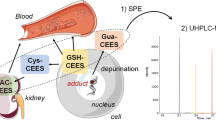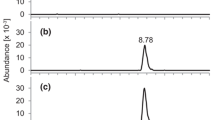Abstract
In mammalian species, including man, N-acetyl-S-(2-hydroxyethyl)-L-cysteine (2-HEMA) is a common urinary metabolite of a large number of structurally different xenobiotic chemicals. It is a common urinary end product of glutathione pathway metabolism of a variety of chemicals possessing electrophilic properties and, in most cases, also a genotoxic potential. Five different chemically reactive intermediates, with different electrophilic properties, may be involved in the formation of 2-HEMA. An inventory of chemicals known to lead to the formation of 2-HEMA, or based on their chemical structure expected to do so, is presented. Furthermore, an attempt is made to evaluate the possibilities and limitations in terms of the potential use of urinary 2-HEMA as a tool in biomonitoring studies. Two other related, sulfur-containing urinary metabolites, i. e. N-acetyl-(S-carboxymethyl)-L-cysteine and thio-diacetic acid, are proposed as possible alternatives to urinary 2-HEMA. It is suggested that 2-HEMA might be seen as a potentially useful and sensitive signal parameter for the assessment of exposure of animals and man to a variety of electrophilic and therefore potentially toxic xenobiotic chemicals.
Similar content being viewed by others
References
Anders MW, Pohl LR (1985) In: Anders MW (ed). Bioactivation of foreign compounds. Academic Press, Inc., Orlando, Fla., USA, pp 283–315
Bernard A, Lauwerys R (1986) Present Status, and trends in biological monitoring of exposure to industrial chemicals. J Occup Med 28: 558–562
Bladeren PJ van, Buijs W, Breimer DD, Gen A van der (1980) The synthesis of mercapturic acids and their methyl esters. Eur J Med Chem 15: 495–497
Bladeren PJ van, Breimer DD, Huygevoort JATCM van, Vermeulen NPE, Gen A van der (1981a). The metabolic formation of N-acetyl-S-2-hydroxyethyl-L-cysteine from tetradeutero-1,2-dibromoethane: relative importance of oxidation and glutathione conjugation in vivo. Biochem Pharmacol 30: 2499–2505
Bladeren PJ van, Breimer DD, Rotteveel-Smijs GMT, Knijff P de, Mohn GR, Meeteren-Wälchli B van, Buijs W, Gen A van der (1981b) The relation between the structure of vicinal dihalogen compounds and their mutagenic activation via conjugation to glutathione. Carcinogenesis 2: 499–505
Bladeren PJ van, Delbressine LPT, Hoogeterp JJ, Beaumont AHGM, Breimer DD, Seutter-Berlage F, Gen A van der (1981c) Formation of mercapturic acids from acrylonitrile, crotonitrile, and cinnamonitrile by direct conjugation and via an intermediate oxidation process. Drug Metab Disp 9: 246–249
Bolt HM, Filser, S-G, Oesch F, Guenter TM, Friedberg T, Bolt M (1981) Metabolisiering von Vinylchlorid: Unterschiede zwischen Mensch und Versuchstier. In: Schäcke G, Stollenz E (eds) Verr. d. DGAM e.V. 21. Jahrestagung, 13.-16. 5. 1981. Gentner Verlag, Stuttgart.
Bolt HM (1984) Metabolism of genotoxic agents; halogenated compounds, In: Monitoring human exposure to carcinogenic and mutagenic agents. IARC Scientific Publications, pp 63–71
Bolt HM, Laib RJ, Klein KP (1981) Formation of preneoplastic hepatocellular foci by vinyl fluoride in newborn rats. Arch Toxicol 47: 71–78
Bowdon BJ, Wheeler GP, Adamson DJ, Shealy YF (1984) Chemical properties and biological effects of 2-haloethyl sulfonates. Biochem Pharmacol 33: 2951–2956
Buijs W, Eid MIA, Onkenhout W, Vermeulen NPE, Gen A van der (1986) The use of sulfenyl halides in the synthesis of mercapturic acids and their esters. Recl Trav Chim Pays-Bas 105: 449–455
Buijs W, Meeteren-Wälchi B van, Smidt PC de, Vermeulen NPE, Booister-Schrijnemakers JGM, Gen A van der, Mohn GR (1988) The influence of metabolic activation on the mutagenic activity of α,ω-dihalogenoalkanes in Salmonella Typhimurium TA-100. Mutat Res (in press)
Colacci A, Arbellini G, Mazullo M, Prodi G, Grilli S (1985). Res Comm Chem Pathol Pharmacol 49: 243–245
Coles B (1985) Effects of modifying structure on electrophilic reactions with biological nucleophiles. Drug Metab Rev 15: 1307–1334
Commandeur JNM, Oostendorp RAJ, Schoofs PR, Xu BJ, Vermeulen NPE (1987) Nephrotoxicity and hepatotoxicity of 1,1-difluoro-2,2-dichloroethylene in the rat: Indications for differential mechanisms of bioactivation. Biochem Pharmacol 24: 4229–4237
Costa AK, Ivanetich KM (1984) Chlorinated ethylenes: their metabolism and effect on DNA repair in rat hepatocytes. Carcinogenesis 5: 1629–1636
Doorn R van, Leydekkers ChM, Bos RP, Brouns RME, Henderson PTh (1981) Detection of human exposure to electrophilic compounds by assay of thioether detoxication products in urine. Ann Occup Hyg 24: 77–92
Draminski W, Trojanowska (1981) Chromatographic determination of thiodiglycolic acid: a metabolite of vinyl chloride. Arch Toxicol 48: 289–292
Edwards K, Jackson H, Jones AR (1970) Studies with alkylating esters-II: A chemical interpretation through metabolic studies of the antifertility effects of ethylene dimethanesulphonate and ethylene dibromide. Biochem Pharmacol 19: 1783–1789
Elfarra AA, Jakobson I, Anders MW (1986) Mechanism of S-(1,2-dichlorovinyl)glutathione-induced nephrotoxicity. Biochem Pharmacol 35: 283–288
Farmer PB, Neumann HG, Henschler D (1987) Estimation of exposure of man to substances reacting covalently with macromolecules. Arch Toxicol 60: 251–260
Furois-Corbin S, Pullman B (1985) Specificity in carcinogen DNA interaction: a theoretical exploration of the factors involved in the effect of neighboring bases on N-methyl-N-nitrosoureas alkylation of DNA. Chem Biol Interact 54: 9–13
Gérin M, Tardif R (1986) Urinary N-acetyl-S-2-hydroxyethyl-Lcysteine in rats as a biological indicator of ethylene oxide exposure. Fund Appl Toxicol 7: 419–423
Godeneche D, Moreau MF, Madelmont JC, Duprat J, Plagne R (1982) Disposition and metabolism of 1-(2-chloro-ethyl)-3-(2′,3′,4′-tri-O-acetyl, ribopyranosyl)-1-nitrosourea in rats. Cancer Res 42: 525–529
Godeneche D, Madelmont JC, Moreau MF, Duprat J, Chabard JL, Plagne R, Meyniel G (1985) Metabolic disposition of 2-chloroethyl nitrosocarbamoylcystamine in rats. Drug Metab Dispos 13: 220–225
Green T, Hathway DE (1977) The chemistry and biogenesis of the S-containing metabolites of vinyl chloride in rats. Chem Biol Interact 17: 137–143
Grunow W, Altman HJ (1982) Toxicokinetics of chloroethanol in the rat after single oral administration. Arch Toxicol 49: 275–284
Guengerich FP, Mason PS, Scott WT, Fox TR, Watanabe PG (1981) Roles of 2-haloethylene oxides and 2-haloacetaldehydes derived from vinyl bromide and vinyl chloride in irreversible binding to protein and DNA. Cancer Res 41: 4925–4933
Haddow A, Ross WCJ (1956) Tumor growth-inhibitory alkyl sulfonates. Nature 177: 995–996
Hemminki K, Vainio H (1984), Human exposure to potentially carcinogenic compounds. In: Monitoring human exposure to carcinogenic and mutagenic agents. IARC Scientific Publications, pp 37–45
Henschler D (1985) In: Anders MW (ed.) Bioactivation of foreign compounds. Academic Press, Inc., Orlando, Fla., USA, pp 317–347
IARC Monographs (1982) Chemicals, industrial processes and industries associated with cancer in humans, suppl. 4. Lyon, France, Vol 1–29
Inskeep BP, Koga N, Cmarik JL, Guengerich FP (1986) Covalent binding of 1,2-dihaloalkanes to DNA and stability of the major DNA adduct, S-[2-(N 7-guanyl)ethyl]glutathione. Cancer Res 46: 2839–2844
Jones BK, Hathway DE (1978) The biological fate of vinylidene chloride in rats. Chem-Biol Interact 20: 27–41
Jones AR, Wells G (1981) The comparative metabolism of 2-bromoethanol and ethylene oxide in the rat. Xenobiotica 11: 763–770
Koga N, Inskeep PB, Harris TM, Guengerich FP (1986) S-[2-(N 7-guanyl)ethyl]glutathione, the major DNA adduct formed from 1,2-dibromoethane. Biochemistry 25: 2192–2198
Kramer RA, McMenamin MG, Boyd MR (1986) In vivo studies on the relationship between hepatic nitrosourea (MeCCNU). Toxicol Appl Pharmacol 85: 221–230
Lewalter J, Korallus U (1986) Erythrocyte protein conjugates as a principle of biological monitoring for pesticides. Toxicol Lett 33: 153–165
Liebler DC, Meredith MJ, Guengerich FP (1985) Formation of glutathione conjugates by reactive metabolites of vinylidene chloride in microsomes and isolated hepatocytes. Cancer Res 45: 186–193
Lohman PHM, Baan RA, Fichtinger-Schepman AMJ, Muysken-Schoen MA, Lansbergen RJ, Berends F (1985) Molecular dosimetry of genotoxic damage: biochemical and immunochemical methods to detect DNA damage. TIPS Nov FEST Suppl: 5–11
Madlo Z, Kubiskova R, Svobodova P, Simova M (1981) Determination of the vinylchloride metabolite S-(2-hydroxyethyl)-N-acetyl-cysteine in urine. Prac Lek 33: 319–323
McKenna MJ, Zempel JA, Madrid EO, Braun WH, Gering PJ (1978) Metabolism and pharmacokinetic profile of vinylidene chloride in rats following oral administration. Toxicol Appl Pharmacol 45: 821–835
Morgan IR, Holdiness MR, Gillen LE (1983) Semin Oncol 10: 56–61
Müller G, Heger M, Norpoth K (1980) Bestimmung der Hydroxyäthyl-Mercaptursäure im Harn Vinylchlorid-Exponierter: Methodische Erfahrungen und analytische Ergebnisse. In: Verhandlungen der Deutschen Gesellschaft für Arbeitsmedizin, 20. Gentner Verlag, Stuttgart, pp 533–536
Müller G, Verkoyen C, Soton N, Norpoth K (1987) Urinary excretion of acrylonitrile and its metabolites in rats. Arch Toxicol 60: 464–466
Onkenhout W (1985) Gas chromatography and mass spectrometry of mercapturic acids: Applications in biotransformation studies of xenobiotics. PhD thesis, University of Leiden
Onkenhout W, Vermeulen NPE, Luijten WCMM, Jong HJ de (1983) Electron impact mass spectrometric analysis of mercapturic acid methyl esters. Fragmentation of mercapturic acids according to “retro-Michael reactions”. Biomed Mass Spectrom 10: 614–619
Onkenhout W, Mulder PJJ, Boogaard PJ, Buijs W, Vermeulen NPE (1986) Identification and quantitative determination of mercapturic acids formed from Z- and E-1,3-dichloropropene by the rat, using gas chromatography with three different detection techniques. Arch Toxicol 59: 235–241
Osterman-Golkar S, Ehrenberg L (1982) Covalent binding of reactive intermediates to hemoglobin as an approach for determining the metabolic activation of chemicals — ethylene. Drug Metab Rev 13: 647–660
Perrard M-H (1985) Mutagenicity and toxicity of chloroethylene oxide and chloroacetaldehyde. Experientia 41: 676–677
Peter H, Appel KE, Berg R, Bolt HM (1983) Irreversible binding of acrylonitrile to nucleic acids. Xenobiotica 13: 19–25
Shaw IC, Graham McLean AEM (1983) 2-Chloroacetaldehyde, a metabolite of cyclophosphamide in the rat. Xenobiotica 13: 433–437
Sittert NJ van, Jong G de (1985) Biomonitoring of exposure to potential mutagens and carcinogens in industrial populations. Fd Chem Toxicol 23: 23–31
Storer RD, Conolly RB (1985) An investigation of the role of microsomal oxidative metabolism in the in vivo genotoxicity of 1,2-dichloroethane. Toxicol Appl Pharmacol 77: 36–46
Tardif R, Goyal R, Brodeur J, Gérin M (1987) Species differences in the urinary disposition of some metabolites of ethylene oxide. Fund Appl Toxicol 9: 448–453
Törnqvist M, Osterman-Golkar S, Kautiainen A, Jensen S, Farmer PB, Ehrenberg L (1986) Tissue doses of ethylene oxide in cigarette smokers determined from adduct levels in hemoglobin. Carcinogenesis 7: 1519–1521
Vermeulen NPE, Onkenhout W, Bladeren PJ van (1983) In: Frigerio A. (ed) Chromatography and mass spectrometry in biomedical sciences Vol. 2. Elsevier Scientific Publishing Co., Amsterdam, pp 39–52
Vermeulen NPE (1988) Toxicity-related stereoselective biotransformation. In: Gorrod JW, Oelschläger H, Caldwell J (eds) Metabolism of xenobiotics. Taylor and Francis, London, pp 353–369
Author information
Authors and Affiliations
Rights and permissions
About this article
Cite this article
Vermeulen, N.P.E., de Jong, J., van Bergen, E.J.C. et al. N-acetyl-S-(2-hydroxyethyl)-L-cysteine as a potential tool in biological monitoring studies?. Arch Toxicol 63, 173–184 (1989). https://doi.org/10.1007/BF00316366
Received:
Revised:
Accepted:
Issue Date:
DOI: https://doi.org/10.1007/BF00316366




